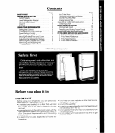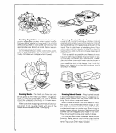
Removing and adjusting the freezer shelf...
,I
To remove shelf:
1. Lift front slightly
2. Lift back off supports
3. Replace in reverse order.
To ad)ust shelf:
1. Remove shelf.
2. Remove supports by sliding upwards
3 Replace supports on desired level.
4. Replace shelf
Ice cube trays.. .
If cubes are not used, they may shrrnk The moving
cold air starts a slow evaporatron The longer cubes
are stored, the smaller they get.
To remove Ice:
1. Hold tray at both ends.
2. Slightly twist.
Optional automatic ice maker.. .
If you have the automatic ice maker accessory or
plan to add one later (Part No. ECKMF-83). there are a
few things you will want to know:
l
The ON /OFF lever IS a wire signal arm.
Down...for making ice automatically:
Up...toshut off the ice maker.
l
Shake the bin occasronally to keep cubes sepa-
rated, and to obtain increased storage capacity.
On
Lower Signal
\
Raise Signal
Arm to Start It.
Arm to Stop Ice Maker.
l
It is normal for ice crescents to be attached by a
corner. They will break apart easily.
l
You WIII hear water running when ice maker is
working. You’ll hear ice fall into the bin. Don’t let
these sounds bother you.
l
The ice maker will not operate until the freezer is
cold enough to make ice. This can take overnight.
l
Because of new plumbing connections. the first
ice may be drscolored or off-flavored Discard the
first few batches of ice.
l
If ice
IS
not being made fast enough and rnme Ice
is needed, turn the Refrigerator Control toward a
higher number. Wait a day and, if necessary, turn
the Freezer Control toward A.
l
If you remove the Ice bin, raise the signal arm to
shut off the Ice maker. When you return the bin,
push it all the way in and lower the arm to the ON
position.
l
If cubes are stored too long, they may develop an
off-flavor...like stale water. Throw them away. They
will be replaced Cubes in the ice bin can also
become smaller by evaporation.
l
Good water quality is important for good ice quality
It is not recommended that the ice maker be con-
nected to a softened water supply. Water softener
chemicals such as salt from a malfunctioning soft-
ener can damage the ice maker mold and lead to
poor quality ice. If a softened water supply cannot
be avoided, then it is important that the water soft-
ener be well maintained and operating properly.


















